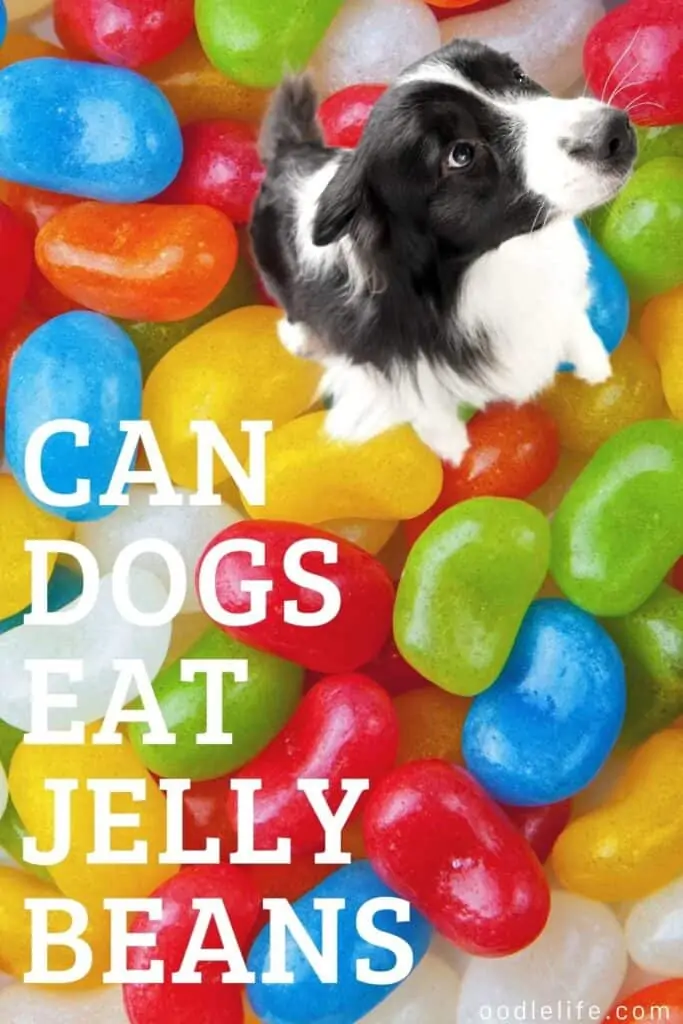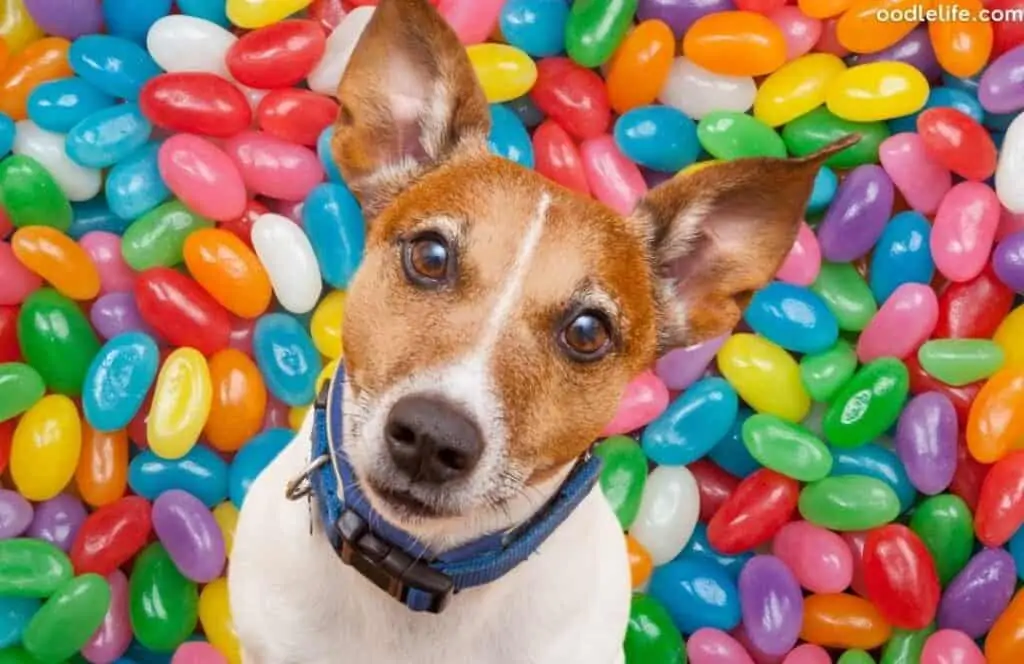Can Dogs Eat Jelly Beans? [when to be WORRIED]
Fewer things are as scary as realizing your beloved dog helped himself to something he shouldn’t have. So, if you encounter some slobber in your bowl of jelly beans, it’s probably got you thinking-can dogs eat jelly beans?

Dogs should never eat jelly beans because many contain toxic ingredients. That said, depending on the type and quantity of jelly beans your dog consumed, it may or may not be a life-threatening situation.
In this guide, we’ll cover the must-knows about the impact of jelly beans on dogs so that you know how to handle this unusual predicament.
First Things First
When you discover that your dog ate jelly beans, you should call your veterinarian immediately if your dog looks unwell. If your dog acts okay, then track down the ingredient list of the jelly beans it consumed; some have fewer toxic ingredients than others.
In either case, it’s wise to give your vet a call to get their opinion. Of course, the quantity of jelly beans plays a role in the possibility of health issues too. If your dog has a sweet tooth and ate half the bag, it’s a different situation than if it ate a jelly bean that rolled out of your hand onto the floor.
What Makes Jelly Beans Unhealthy for Dogs?

You probably don’t need me to tell you this, but I’m going to put it out there anyway-jelly beans offer no nutritional value for dogs.
Because of a jelly bean’s high sugar and carbohydrate content, it can be devastating to your dog’s health if it has pre-existing conditions. Examples of diseases that can complicate jelly bean consumption include:
- Diabetes
- Heart disease
- Liver disease
- Skin sensitivities
- Obesity
- Gastrointestinal issues
In addition to pre-existing conditions, a dog’s age can impact how much of an adverse reaction it may have. The older a dog is, the more likely it’ll suffer from problems. Similarly, puppies can also struggle with jelly bean side effects more than a middle-aged adult dog.
Dangerous Ingredients in Jelly Beans
Jelly beans contain dozens of ingredients, and there are a handful that can cause serious harm to your dog if they consume them. Luckily, not all jelly beans have all of these toxic ingredients, which is why we recommend reading the label.
Additionally, as we mentioned earlier, the number of jelly beans your dog ate will depend on just how bad of a reaction it has if it has one at all.
Below are the ingredients in jelly beans that are toxic to dogs.

Xylitol
Xylitol is an artificial sweetener that is deadly to dogs. Jelly beans are one of many foods and products people have in their homes that contain xylitol-peanut butter and mouthwash are other examples.
When dogs consume xylitol, it forces their blood sugar to drop, causing hypoglycemia. The impact of xylitol consumption in dogs is usually quick, at around 30 minutes. However, it depends on how fast or slow your dog’s body digests the jellybeans. Therefore, you should keep an eye out for hypoglycemia in the 24-hour period after your dog consumes the candy.
Signs that your dog has hypoglycemia include:
- Vomiting
- Drooling more than normal
- Seizures
- Unsteady movements
Taking your dog to the vet right away if they show signs of hypoglycemia is critical for preventing liver failure and death. Lots of different types of black licorice, jelly belly, gummy bears, licorice root treats, ice cream, sweet pretzels, and grape jelly have this artificial sweetener as an ingredient. A dog owner must go ourt of their way to strictly avoid giving their furry friend such candy or any sugary treat.
Caffeine
You may not think of jelly beans as a source of caffeine, but this is the case for some brands. Caffeine is toxic to dogs for the same reason that chocolate is-it contains theobromine.
However, caffeine toxicity in dogs happens within a shorter period than xylitol-usually between 45 minutes to two hours. Signs that caffeine is harming your dog include:
- Fast heartbeat
- Extra energy
- Shaking
- Hyperthermia
If your dog is showing signs of caffeine poison, take it to the vet immediately. Provided that your vet can see him quick enough, they should be able to support your dog to prevent death.
Sugar
Whether it be artificial sweeteners or the real thing, it goes without saying that your jelly beans contain some form of sugar. Although sugar isn’t good for dogs, it thankfully isn’t as devastating as xylitol and caffeine.
When sugar alone is the culprit of a reaction from jelly beans, your dog may vomit or have diarrhea. However, it usually won’t need a trip to the veterinarian (although given that your pooch could have consumed other toxins, it’s best to take him anyway).
Even though it isn’t an immediate life or death kind of situation, too much sugar in your dog’s diet can lead to the following conditions:
- Heart disease
- Diabetes
- Unhealthy gums
- Arthritis
- Obesity
Long story short, you should never give your dog any sweet human treats.

Starch
Starch is what gives most jelly beans their iconic chewy consistency. When looking at the jelly bean label, you may see “pectin” instead of starch since this is a specific kind of starch.
Pectin and starches are the least dire of the ingredients we’ve talked about. However, your dog may suffer from gut issues-especially constipation-if they eat a lot of jelly beans.
Flavorings
A jelly bean’s delicious flavors have to come from somewhere, and unfortunately, that means from flavorings that aren’t healthy for dogs. It’s natural to assume that I’m talking about artificial flavorings here, but natural flavorings matter, too-flavorings such as cocoa and grape can be detrimental to a dog’s health.
While jelly beans may not have enough of any given flavoring to harm your dog, you should avoid giving your furry companion any human food with added flavors to stay on the safe side.
How Veterinarians Handle Jelly Bean Consumption
Your veterinarian will first and foremost want to know what kinds of jelly beans your dog ate. If possible, you should bring the jelly bean bag with you.
Vets usually handle situations where dogs ate too many jelly beans by making them vomit. While this may be a difficult choice to make for your dog at the moment, you won’t have time to dawdle on making your decision; the purpose of making a dog throw up is to get the toxins out of its body before it absorbs them.
In more severe cases, your veterinarian may recommend that your dog stay overnight so they can monitor its progress.
Can a Single Jelly Bean Be Lethal for Dogs?
Dogs usually don’t have a sweet tooth, so more often than not, if it’s going to eat a jelly bean, it might only be a single one. Unfortunately, if that jelly bean contains xylitol or caffeine, it can still cause death.
For this reason, it’s essential you read the ingredient list in your jelly beans and take your dog to the vet immediately if you see either of these ingredients.

Wrap Up
By now, you should know that it’s a terrible idea to feed jelly beans to a dog. However, if your dog ends up finding the jelly bean bowl on its own, you know what to look out for.
Watch for an upset stomach – from sugars (like in almond milk or soy products) right through to fats (like those in scrambled eggs or green olives) – many foods that dogs LOVE to steal will result in diarrhea. Not all fats are bad though (this is why giving salmon to your dog is a-ok)
As always, if you’re ever in doubt about something your dog ate, you should give your veterinarian a call. They’re the experts and can guide you through the best steps to take so that Fido can return to a life of playing ball and cuddling with you on the couch.